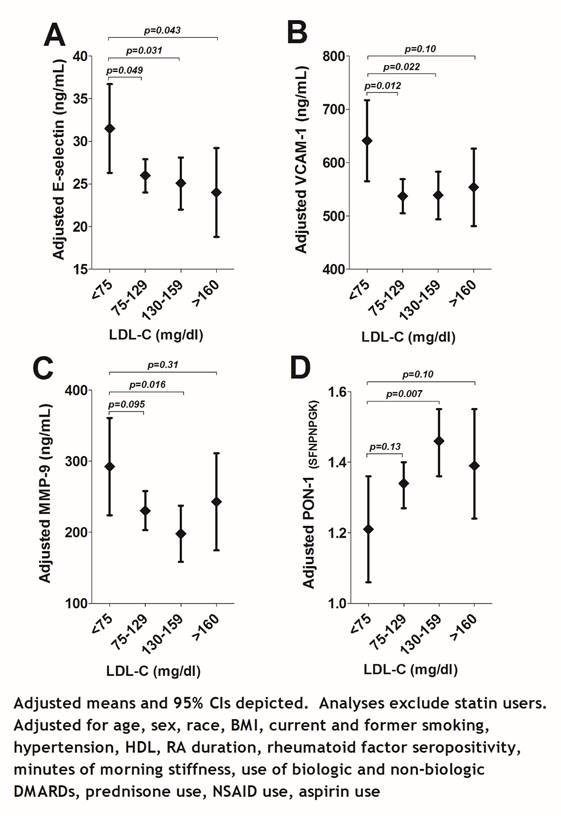Session Information
Date: Monday, October 22, 2018
Title: 4M086 ACR Abstract: RA–DX, Manifestations, & Outcomes II: DX & Prognosis I (1858–1863)
Session Type: ACR Concurrent Abstract Session
Session Time: 2:30PM-4:00PM
Background/Purpose: Rheumatoid arthritis (RA) patients with very low levels of circulating low density lipoprotein cholesterol (LDL-C) have been reported to be at particularly high risk for cardiovascular disease (CVD) events. Previously, we reported that this subgroup also had markedly elevated coronary calcium scores, a surrogate for atherosclerosis; however, the mechanisms underlying these seemingly paradoxical findings has not been explored.
Methods: RA patients from 3 cardiovascular cohort studies underwent measurement of fasting serum lipids and a panel of 32 cytokines, chemokines, metalloproteinases, and other immune mediators associated with CVD was measured from serum using various optimized methods (ELISA, Luminex, liquid chromatography/tandem mass spectrometry). Levels of each panel biomarker were compared according to LDL strata, with the lowest stratum (LDL-C<75 mg/dL) being the stratum of interest, using multivariable robust regression to adjust for pertinent confounders.
Results: A total of 454 RA patients [mean age=57 years; 74% female; median RA duration=10 years] were studied. LDL-C<75 mg/dL was observed in 10%, and 32% had an LDL-C>130 mg/dL. Excluding statin users (n=64), those in the lowest LDL-C stratum did not differ from those in higher strata on demographics, CVD risk factors, or RA disease and treatment characteristics with the exception of BMI and waist circumference, which were lower in the lowest LDL-C stratum compared with the highest, and ever and current smoking, which were more prevalent in the lowest LDL-C stratum. After adjustment, mean levels of pro-atherogenic E-selectin, vascular cell adhesion molecule-1 (VCAM-1), and matrix metalloproteinase-9 (MMP-9) were higher among those in the lowest LDL-C stratum compared with those with higher LDL-C levels (Fig A-C). In contrast, levels of anti-atherogenic paraoxonase-1 (PON-1) were lowest among those in the lowest LDL-C stratum (Fig D). Seropositivity for rheumatoid factor (RF) was more strongly associated with higher E-selectin, MMP-9, and VCAM-1 levels among those in the lowest LDL-C stratum compared with those with higher LDL-C. Likewise, RF was more strongly associated with lower PON-1 levels among those in the lowest LDL-C stratum.
Conclusion: Higher levels of vascular adhesion molecules and metalloproteinases and lower levels of PON-1 suggest a pro-atherogenic state that would typically not be observed among those with low LDL-C, a group generally at low risk for CVD. Such a pro-atherogenic state may account for higher CVD events and atherosclerosis among RA patients with low LDL-C levels and identify a subgroup that may benefit from heightened CVD screening and prevention.
To cite this abstract in AMA style:
Giles JT, Chung CP, Chester-Wasko M, Centola M, Van Eyk J, Fert-Bober J, Kao A, Oeser AM, Stein CM, Bathon J. Exploring the Lipid Paradox Theory in Rheumatoid Arthritis: Very Low Circulating Low-Density Lipoprotein Concentration Levels Are Associated with Pro-Atherogenic Biomarkers [abstract]. Arthritis Rheumatol. 2018; 70 (suppl 9). https://acrabstracts.org/abstract/exploring-the-lipid-paradox-theory-in-rheumatoid-arthritis-very-low-circulating-low-density-lipoprotein-concentration-levels-are-associated-with-pro-atherogenic-biomarkers/. Accessed .« Back to 2018 ACR/ARHP Annual Meeting
ACR Meeting Abstracts - https://acrabstracts.org/abstract/exploring-the-lipid-paradox-theory-in-rheumatoid-arthritis-very-low-circulating-low-density-lipoprotein-concentration-levels-are-associated-with-pro-atherogenic-biomarkers/

